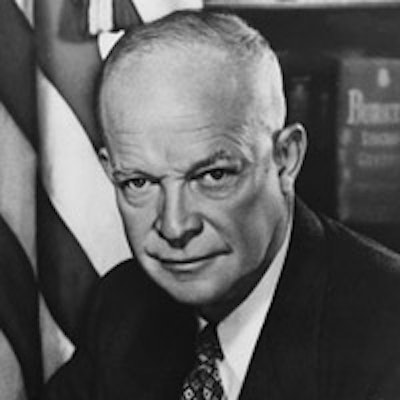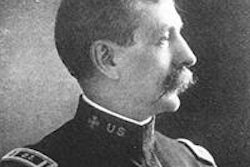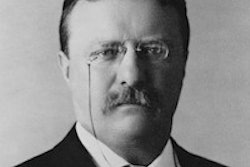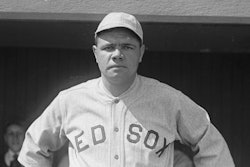
In 1954, Americans were enjoying a relatively carefree and prosperous time. The stresses and heartache of World War II were, for the most part, in the past. The heroes of the early 1950s were now found on the fields of athletic competition and the silver screen, which was filled with the adventure and glamour of Hollywood's stars and starlets. 1954 saw Americans visit their local movie theaters to see Humphrey Bogart in "The Caine Mutiny" or Marlon Brando in "On the Waterfront." Sports enthusiasts cheered on their favorite teams as the New York Giants won the World Series and the Cleveland Browns captured the NFL championship.
However, the early 1950s also saw the effects of the sustained state of political and military tension between the U.S. and the Eastern Bloc nations. This time period witnessed the signing of the Mutual Defense Treaty between the U.S. and South Korea, 11 nuclear tests yielding a total of 252 kilotons at the Nevada Test Site, Watson and Crick describing to the world the structure of DNA, and the death of Joseph Stalin.
 President Dwight D. Eisenhower.
President Dwight D. Eisenhower.
Dwight D. Eisenhower was inaugurated as the 34th president of the United States on January 20, 1953. Eisenhower brought much worldly experience to the White House. He was a five-star general in the U.S. Army during World War II, the supreme commander of Allied forces in Europe, and the first supreme commander of NATO.
Eisenhower also had many dental issues. These dental issues included periodontitis, which stabilized after he quit smoking; a parafunctional grinding habit; and many fractured teeth. He also had a "porcelain cap on his upper left central incisor" -- tooth No. 9.
This one crown would become the focal point of historians and various other individuals with immensely diverse interests well into the 21st century. This crown had a difficult history from the beginning. It was cemented on Eisenhower's tooth in July 1952. It chipped and needed to be repaired only five months later in December. It would eventually have to be replaced by the president's dentist, Col. James M. Fairchild, in July 1954 when he placed "a thin gold/platinum thimble crown."
On the evening of February 20, 1954, Eisenhower's crown on tooth No. 9 ceased being like any other crown. He was in Palm Springs, CA, for a vacation scheduled in an oddly rushed manner. Also, a bit peculiar was the fact that Eisenhower had just returned the previous week from a "quail shooting" vacation in Georgia. Eisenhower was not the type of person to spend much time on vacation.
Nonetheless, Friday, February 20, started out as simple, nondramatic day in the life of the president. He wrote a letter to his son, John, detailing his two previous days in California. He told his son that he had a good round of golf, playing with professional golfer Ben Hogan.
However, everything changed around 8 p.m. when he was whisked off to an undisclosed location. The press heard that Eisenhower was not where he was supposed to be and was unaccounted for. Speculation abounded concerning the president's whereabouts. Later that night, the Associated Press (AP) issued a statement: "Pres. Eisenhower died tonight of a heart attack in Palm Springs." This statement was retracted by the AP only two minutes later, calling it a mistake. However, fuel was added to the fire.
Fear for the safety of both the president and the nation abounded through the night among those aware of the situation. The fear of the unknown disappeared the next morning as the president and Mrs. Eisenhower attended religious services, conducted by Rev. James Blackstone Jr., at the Palms Springs Community Church. Later in the day, a dentist, Dr. Francis Purcell, was introduced at an event as "the dentist who treated the president last night."
Oddly, Dr. Purcell must not have thought it worth mentioning to Mrs. Purcell that he provided emergency dental treatment to the president of the United States. Mrs. Purcell stated in a 1979 interview that she had no recollection of her husband ever treating Eisenhower. No dental records mentioning his dental treatment were ever found in Dr. Purcell's office.
In the next few days, Eisenhower returned home to the White House, refreshed from his California vacation. Approximately, one week later on March 1, the U.S. performed its first nuclear test of a dry fuel hydrogen bomb at Bikini Atoll under code name Castle Bravo. It did not go according to expectations. The test resulted in a 15-megaton yield, while predictions were for a 6-megaton yield. While wild speculation persists as to Eisenhower's whereabouts on February 20, one has to wonder if Castle Bravo's planning was related to Eisenhower's dental emergency.
Special thanks John Joyce, park ranger at the Eisenhower National Historic Site, for information in researching this article.
References
- Carlson P. Ike and the alien ambassadors. Washington Post. February 19, 2004:c01.
- Eisenhower's presidential appointment books. https://www.eisenhower.archives.gov/research/online_documents.html#presbooks. Accessed February 3, 2014.
- Letter from President Eisenhower to John S.D. Eisenhower. February 20, 1954.
- Mixson JM. A history of Dwight D. Eisenhower's oral health. J Hist Dent. 1995;43(3):93-103.



















